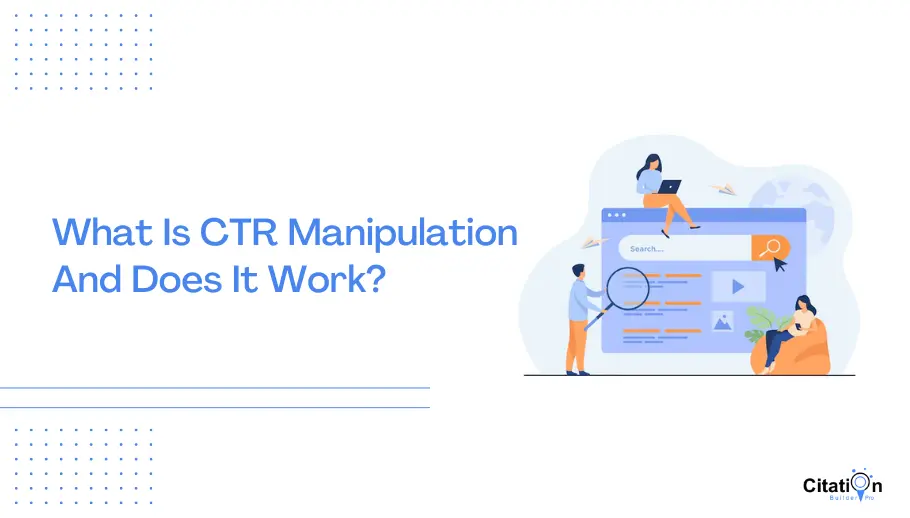Achieve Better Outcomes With Smart CTR Control Approaches
In the competitive landscape of electronic advertising, attaining premium outcomes with clever CTR control methods is necessary for driving engagement and conversions. This includes a detailed understanding of target market habits, paired with targeted messaging and constant optimization through A/B screening. By concentrating on components such as compelling headlines and calculated visuals, marketing experts can substantially improve their click-through prices. The actual obstacle lies in properly keeping track of these metrics and making timely modifications-- an aspect that often stays neglected. What specific tactics can be utilized to make sure continual success in this vibrant environment?
Recognizing Click-Through Fees
Click-through rates (CTR) work as a vital statistics in digital advertising, mirroring the efficiency of on-line web content in engaging customers. CTR is specified as the ratio of users that click on a details web link to the complete variety of users that view the content, shared as a percentage. A greater CTR suggests that the content reverberates with the target market, motivating them to take action, while a lower CTR may suggest the need for renovation in messaging or presentation.
A number of aspects affect CTR, consisting of the top quality of the web content, the relevance of key phrases, and the beauty of calls-to-action (CTAs) Well-crafted headlines can dramatically boost individual rate of interest, driving more clicks. In addition, visual elements such as pictures and videos can improve involvement, making the material much more appealing.
Recognizing CTR is essential for maximizing digital advertising approaches. Marketing experts can examine CTR information to recognize trends and make informed choices regarding content adjustments, targeting techniques, and total campaign efficiency. By continuously monitoring and improving these elements, organizations can pursue attaining much better engagement and ultimately, higher conversion prices.
Relevance of Targeted Messaging
Effective interaction in digital marketing needs greater than just compelling visuals and appealing web content; it requires a deep understanding of the target market. CTR Manipulation. Targeted messaging is critical due to the fact that it allows marketers to customize their interactions to details segments, ensuring that the messaging reverberates with the needs, preferences, and discomfort factors of possible consumers
When messages are straightened with the audience's passions, the possibility of engagement raises significantly. This approach not only enhances click-through rates (CTR) but likewise cultivates a deeper connection in between the brand name and its audience. By making use of data analytics, marketing professionals can recognize demographic factors such as age, place, and purchasing habits, enabling them to craft tailored messages that speak directly to specific consumers.

A/B Examining for Optimization
Optimization is an essential part of effective electronic marketing methods, and A/B testing works as an effective tool in this procedure. This approach permits marketers to contrast 2 or more variants of a project aspect, such as headlines, images, or call-to-action switches, to identify which version generates the highest possible click-through rate (CTR)
By arbitrarily segmenting your target market and subjecting each team to a various version of the advertising and marketing material, A/B testing gives empirical data relating to customer preferences and habits. The understandings obtained from these tests allow online marketers to make data-driven decisions, making certain that resources are alloted effectively for maximum influence.
To implement A/B testing successfully, it is necessary to specify clear purposes and establish vital performance indications (KPIs) for measurement. Running examinations over an adequate duration and ensuring statistically substantial sample sizes are essential to drawing valid final thoughts.
Ultimately, A/B testing not just improves the performance of individual advertising and marketing components but likewise adds to a broader understanding of customer behavior. By continuously improving strategies based on test outcomes, marketing experts can achieve continual improvements in CTR and overall project performance, resulting in greater return on investment.

Utilizing Behavioral Insights
By leveraging behavioral understandings, marketers can gain a much deeper understanding of consumer inspirations and choices, allowing them to craft more targeted and engaging projects. Behavioral insights include different data points, including previous purchase habits, website communications, and involvement patterns. Assessing these elements enables marketing experts to determine trends that notify content creation and network option.
For instance, understanding height interaction times can assist marketing professionals schedule projects when customers are most responsive. By segmenting target markets based on their behavioral patterns, customized messages can reverberate extra properly, enhancing click-through prices (CTR) Furthermore, identifying the psychological triggers that result in conversions can assist the advancement of persuasive copy and visuals.
Eventually, making use of these understandings not just boosts CTR but also fosters stronger consumer relationships, leading to greater retention prices. In an affordable landscape, the calculated application of behavior insights is vital for driving meaningful engagement and accomplishing sustainable advertising success.
Monitoring and Changing Techniques
Continual tracking and change of advertising and marketing strategies are important for maximizing click-through prices (CTR) and making certain article project efficiency. To attain this, marketing experts should establish crucial efficiency signs (KPIs) that line up with their objectives, enabling for real-time evaluation of project efficiency. This data-driven technique allows teams to determine patterns and fads that are vital in comprehending audience behavior.
Routinely assessing advertisement efficiency, consisting of impacts, clicks, and interaction metrics, facilitates prompt modifications. If a certain advertisement set underperforms, it might necessitate adjustments in copy, visuals, or targeting parameters. A/B testing is a reliable approach to compare different versions of advertisements and discern which components reverberate more with the target market.

Conclusion
Finally, reliable click-through rate (CTR) adjustment strategies necessitate a detailed understanding of audience actions and preferences. Prioritizing targeted messaging, engaging material, and A/B screening can dramatically boost campaign performance. The assimilation of behavioral understandings further improves these efforts, bring about more resonant interaction. Continuous monitoring and modification of methods ensure responsiveness to adjustments in engagement metrics, ultimately optimizing conversion prices and driving successful advertising end results.